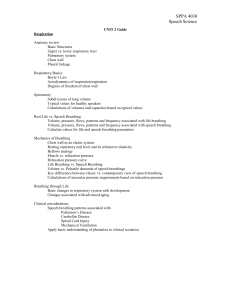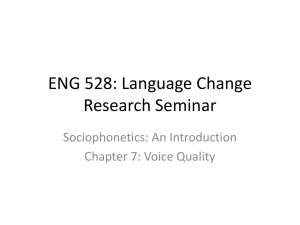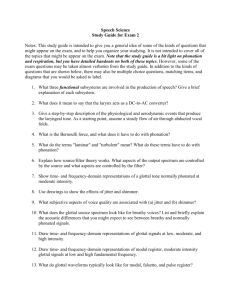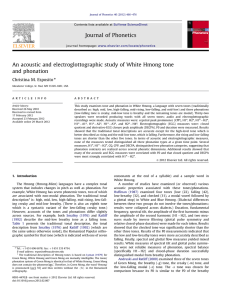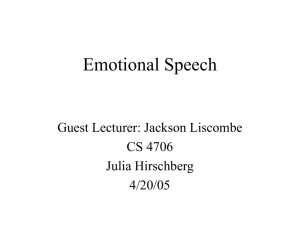Gordon et al_ JPh_2004_phonationtypes
advertisement
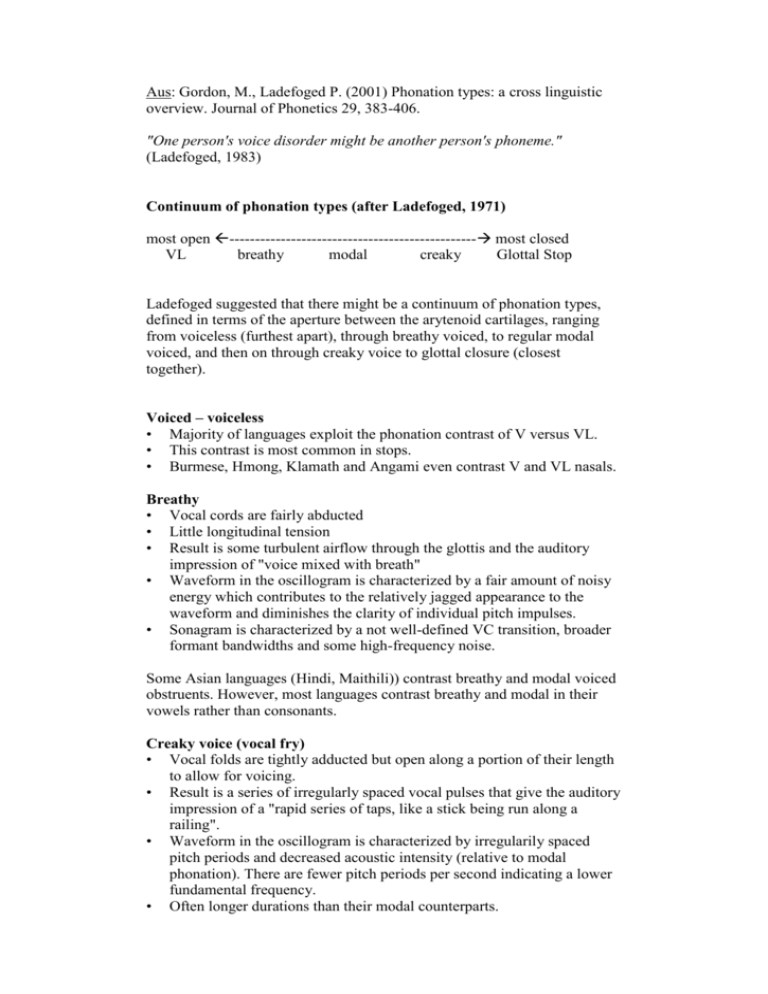
Aus: Gordon, M., Ladefoged P. (2001) Phonation types: a cross linguistic overview. Journal of Phonetics 29, 383-406. "One person's voice disorder might be another person's phoneme." (Ladefoged, 1983) Continuum of phonation types (after Ladefoged, 1971) most open ------------------------------------------------ most closed VL breathy modal creaky Glottal Stop Ladefoged suggested that there might be a continuum of phonation types, defined in terms of the aperture between the arytenoid cartilages, ranging from voiceless (furthest apart), through breathy voiced, to regular modal voiced, and then on through creaky voice to glottal closure (closest together). Voiced – voiceless • Majority of languages exploit the phonation contrast of V versus VL. • This contrast is most common in stops. • Burmese, Hmong, Klamath and Angami even contrast V and VL nasals. Breathy • Vocal cords are fairly abducted • Little longitudinal tension • Result is some turbulent airflow through the glottis and the auditory impression of "voice mixed with breath" • Waveform in the oscillogram is characterized by a fair amount of noisy energy which contributes to the relatively jagged appearance to the waveform and diminishes the clarity of individual pitch impulses. • Sonagram is characterized by a not well-defined VC transition, broader formant bandwidths and some high-frequency noise. Some Asian languages (Hindi, Maithili)) contrast breathy and modal voiced obstruents. However, most languages contrast breathy and modal in their vowels rather than consonants. Creaky voice (vocal fry) • Vocal folds are tightly adducted but open along a portion of their length to allow for voicing. • Result is a series of irregularly spaced vocal pulses that give the auditory impression of a "rapid series of taps, like a stick being run along a railing". • Waveform in the oscillogram is characterized by irregularily spaced pitch periods and decreased acoustic intensity (relative to modal phonation). There are fewer pitch periods per second indicating a lower fundamental frequency. • Often longer durations than their modal counterparts. Ladefoged differentiates tense phonation from creaky. The former is said to involve increased constriction in the laryngeal area. Creaky voice is used cross-linguistically as a marker of prosodic boundaries, either initially and/or finally. Glottal stop • Complete glottal closure. • No vocal fold vibrations. • Phonemic glottal stops are often realized as creaky phonation on neighboring sounds rather than with complete glottal closure. Some languages contrast modal voice and creaky voice, or contrast creaky with both modal voice and breathy voice. Again contrasts between modal and creaky in stops are rare. However, Hausa and other African languages make such a contrast. The creaky stops in these languages are implosives and involve larnyx lowering as well as a creaky voice quality. Northwest American Indian languages (Montana Salish, Hupa) contrast creaky and modal voicing among sonorants (nasals). A three-way phonation contrast is mainly found for vowels, e.g. in Jalapa Mazatec. Most non-modal phonation settings are realized only on a portion of the sound or some portion of an adjacent sound but hardly ever at the CV transition phase, which provides important information about place and manner of articulation of the consonant. Quantifying phonation differences: Acoustic and aearodynamic characteristics (for more see WiSe0708 "Akustik für Fortgeschritte" 1. aperiodicity can be quantified by jitter = the variation in the duration of successive fundamental frequencies; highest in creaky voice; in breathy voice also increased spectral noise in higher frequencies 2. reduction of acoustic intensity highest in breathy and then creaky voice; reliably quantifiable by spectral tilt = the degree to which intensity drops off as frequency increases: compare the amplitude of F0 and that of higher frequency harmonics, e.g. the second harmonic. Spectral tilt is most steeply positive for creaky voice and most steeply positive for breathy voice with (intermediate values for modal voice). 3. fundamental frequency lowered in non-modal voice 4. first formant is higher during creaky phonation than breathy or modal.

